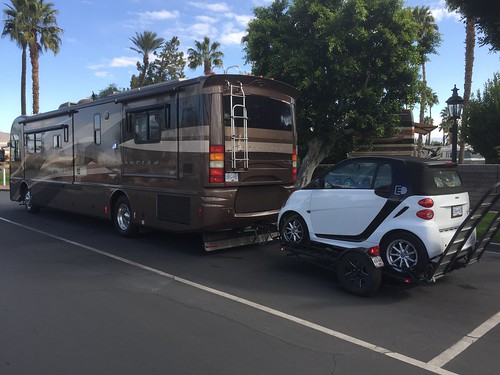Towing 4-down, by the way, is a no-no per the Model Y manual, as you probably know (see image). I guess the motor can never be fully disengaged so towing with any of the wheels on the ground would cause it to regenerate which in this case could cause overheating, damage and possibly ignition.
Sparkler, I hear what you're saying about wanting to engage Tesla's regenerative breaking when you break in the RV. It would be a cool way to help slow the additional weight of the car (as well as maybe charge the battery and help slow the RV; if the Tesla's drive train/battery could handle it).
Strangely, the Tesla doesn't even do that when driving on its own. Unlike a Prius (and probably others), pressing the break pedal in a Tesla does not engage regenerative breaking. It just engages the friction breaks. Releasing the accelerator does engage regenerative breaking. So it's really not accurately named in their case. It's really "regenerative slowing" or "regenerative engine drag" since it's not tied to the break system at all.
I always thought this was a waste of energy. I know, I know, the way they do it facilitates mostly single-pedal driving, and if you drive it right you should rarely have to use your breaks. But I think this is asking people to learn a new way to drive.
The nice thing that Toyota did, being pioneers in the hybrid/electric drivetrain and regenerative breaking space, is they made the car feel like what you were already used to driving (if you drive an automatic). They added two artificial features to mimic an automatic transmission: creep (when you release the break while stopped) and simulated engine drag (when you release the accelerator while driving). And that engine drag would charge the batteries a bit in the process. And then when you break, in a Prius, regenerative breaking is increased. And only when you need it for fast stops or to bring the vehicle to a full stop, do the friction breaks engage.
Now Tesla has those two features as well, but they decided to more aggressively apply the regenerative engine drag, and to do no additional charging at all when you break. I think that's leaving money on the table, so to speak.
I drove my Prius for 10 years and 120,000 miles on a single set of breaks; cause they hardly ever got used). My Model S however, needed new breaks after about 3 years. Now sure, that's a 4500 pound car that I regularly take for a spin on winding mountain roads; something I never did in the Prius. (Yes the Model S was set to Standard regenerative breaking, which is the most aggressive).
Anyway, I think it's best to maintain the momentum a car has when the accelerator is release, versus prematurely trying to get that power back. There's always some loss in the conversion from kinetic energy to battery and back. Best to leave it as kinetic energy until you don't need it anymore, then try to regain that power.




